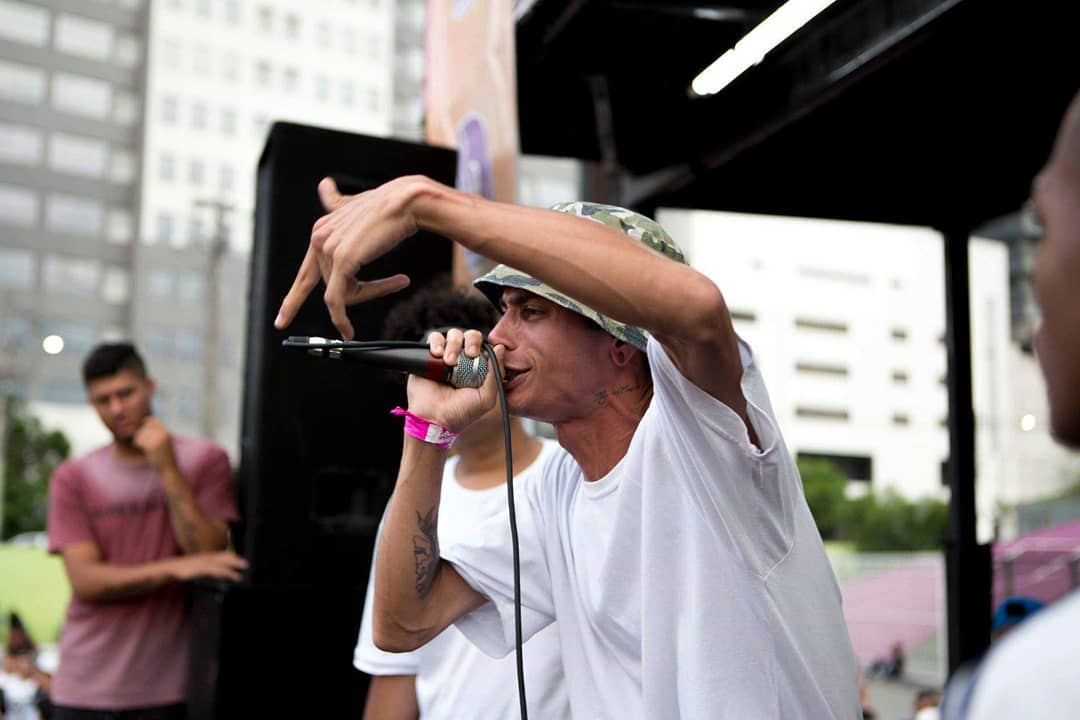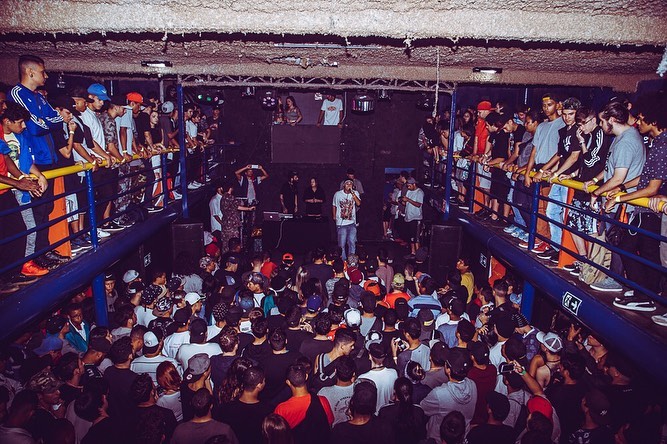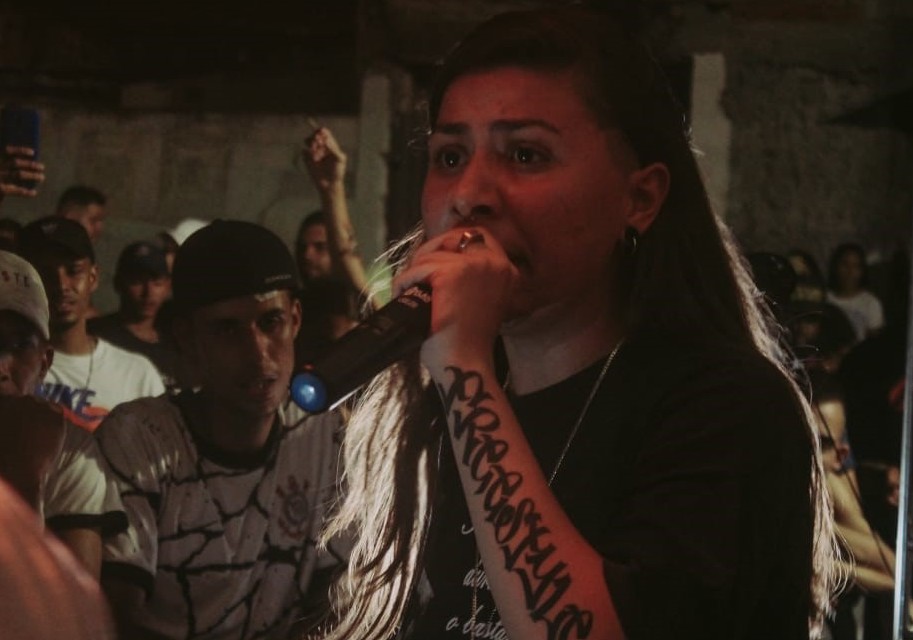
Rap battles bring together several MCs, from newcomers to the most famous in the local Rap scene, such as DuRap | Photo: Disclosure/Used with permission.
This text was authored by Gabriela Santos and Tatiane Araújo. It was originally published in March 2022, by Agência Mural. The article is reproduced here in a partnership agreement with Global Voices.
“If you love this culture like I love this culture, shout hip-hop!”
This sentence is repeated like a mantra, loud and clear, by the competitors and the audience watching yet another rap battle on a hot Friday night on the East Side of São Paulo.
The Brazil Square (Praça Brasil, in Portuguese) in Itaquera is the place that hosts the weekly Battle of Zil, now returning to the in-person format.
Known as one of the largest in the region, this rap battle was created in 2017 and it is notable for its rapid growth since its return in July 2021 — the period when the COVID-19 vaccination campaign gained momentum in Brazil.
The battle has already gathered between 100 and 300 people in the famous neighborhood square. There they watch the disputes between several MCs, as the artists who rhyme and compete in the tournaments are called. Participants range from newcomers to the most famous in the local rap scene, such as MC DuRap.
This type of event has spread throughout the outskirts of São Paulo, Brazil’s largest city, being held in public squares or on the main gates of train stations by young people inspired by rap. However, with the COVID-19 pandemic, in-person events were canceled, and only now it has been regaining strength.
Igor Franulovic, 22, the main organizer and host at Batalha da Zil (Zil’s Battle), points out that the event is a lot more than a musical meeting, but rather “a social project in the peripheral area to reveal artists.”
The student Felipe de Souza, 18, who also acts as an organizer alongside Igão, goes further and says that the battle “is a space to vent, to get to know other realities, and is also a welcoming environment.”
Nisque MC, who lives on the East Side, said she sees in this growing movement a path of new perspectives for the residents of the peripheries.
“In the quebradas (hoods), the option always seems to be soccer or crime. With the battle, we bring different things to the communities and transformation through rap,” she said. “We pass on the vision to the kids.”
Another battle that bets on the transformation of the hoods is the BDA (Battle of Aldeia), one of the main ones in Brazil, according to the organizers and members of other battles throughout the state of São Paulo. It happens every Monday at the Praça dos Estudantes in Barueri in Greater São Paulo.
Always crowded, BDA emerged from the dedication of Bruno Angelo de Souza, 32, better known as Bob 13. The founder lived in Tupã, in the interior of São Paulo, and moved to Barueri in 2016.
During this period, he realized the lack of street actions aimed at young people and combined the dream of making a living out of rhyming with the need to insert the rap movement into the community.
At the time, the average public attending the BDA was more than 2,000 people per night. But in 2020, the pandemic arrived, and plans changed with the ban on events with a large concentration of people.
The organization of the battle was forced to explore new strategies and decided to bet more on the digital space. Bob 13 says that at the beginning of the pandemic he was unsure.
“What a desperate moment, all the battles in the country reached level zero, no power of action and no work available” — Bob 13, from the Battle of Aldeia.
One of his main questions was: “How do we make a rap battle happen with no audience and no MCs face-to-face?”
So he came up with the idea of holding a long-distance rap battle, using only the voice of the participants, through the Discord application.
But it lacked the unique energy of an in-person battle, says the organizer. “Battles that had more than 100,000 hits on YouTube started to have less than 10,000,” he says.
As vaccination progressed and pandemic numbers dropped, they started putting MCs in the studio to record images and thus ensure that the public would watch the performances.

BDA’s Anniversary, 2017 | Photo: Disclosure/Used with permission.
On May 5, 2021, the BDA celebrated its fifth anniversary, there was even a celebration in a concert hall in central São Paulo, including a BRL 60,000 (around USD 11,800) prize for the winners.
Now, in 2022, the battle gradually returns to in-person, with events at the Students’ Square (Praça dos Estudantes). “The public is coming back 100% with us, the views are coming back too, and we will keep working,” he says.
Bob 13 has also been preparing an interstate rap battle and plans a nationwide event to celebrate BDA’s sixth anniversary. The idea is to take the dispute from Barueri to the whole country.
Diversity
Even though the rhyme battles have become an important cultural movement in the peripheries, the scene is still mostly dominated by male participants.
Monique Fortes, 21, known as Nisque MC, is an independent artist who participates daily in several battles around the capital, including Zil’s.

Nisque MC talks about the importance of plurality in the battles | Photo: Disclosure/Used with permission.
When she started in this world eight months ago, male participation was much more intense and even aggressive, she says. Fortunately, it is changing with time.
“I saw, and still see, many girls afraid to battle with men, so it’s important to strengthen the female and LGBTQIA+ community” — Nisque MC
The Battle of Zil went on to promote the Battle of Diversity (diversidade, in Portuguese), to get more women and more people from the LGBTQIA+ community into the scene.
“Initiatives like these make a difference because they break down barriers and add plurality,” says Nisque.
Millena Magalhães, 22, who goes by MC Mi Maya, identifies themselves as a nonbinary person and has also been one of the participants.
Mi Maya is a permanent MC at the Battle of 16 in Morro Doce in the Northwest Side of São Paulo but also participates in other battles, such as Zil’s.
According to Millena, the Battle of Diversity can be a resource for the LGBTQIA+ community at events. It can also be a place of learning for everyone involved, from the rappers to the audience.
Understanding the details can make all the difference, like respecting pronouns. “It’s an environment where we feel comfortable.”
The diversity edition is in the process of being revamped. Igão explains that the idea is promising, but it needs to be organized in the best way so that all participants feel represented.
The Battle of Aldeia, besides charting impressive numbers, also promotes editions that strengthen the involvement of women. This is the case of the Battle of Poisonous Women (Mulheres Venenosas, in Portuguese) which has already more than 14 million views on YouTube.
Support for MCs
“Rap battles transform us. They’re synonymous with freedom of expression. They help us think differently, approach subjects that people are afraid to talk about, and offer us different experiences,” says Igão.
In order to mature this work, he says that in the Battle of Zil the support for the MCs is considered one of the main pillars.
The effort of the work goes back to the community, to the neighborhood culture. Zil pays for the MCs’ travel expenses, from São Paulo or other cities and states, in some cases offering lodging and support, so they can continue in the rap scene.
The money spent comes from YouTube video monetization and from the help of the organizers themselves. Igão and Felipe explain that today, they dedicate themselves to creating a strong identity in the social networks to attract the public and sponsors that can make possible the payment of prizes to the MCs and the remuneration of the team.
One of Zil’s goals is to reach 20,000 subscribers on YouTube in 2022. As of the publication of this report, the battle channel had 11,400 subscribers and Instagram had 8,426 followers.
One of the references is the BDA itself, which, in the pandemic, strengthened its work in the media. Today, the movement has 3.67 million subscribers on YouTube and 1.2 million followers on Instagram.


